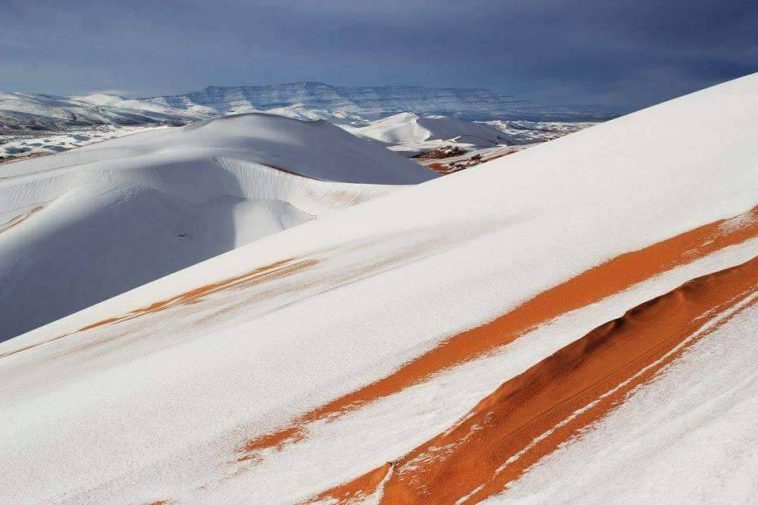Sahara desert in Algeria decided to Change a look and designing an amazing Landscapes Snow Images
Heavy layer of snow has shrouded the Sahara Desert in an oddity winter climate storm. More than 15 inches (40cm) has covered the sand rises over the residential community of Ain Sefra, Algeria.It is the second time snow has hit in about 40 years, previously recorded in December 2016.
Be that as it may, this snowfall which hit 08.01.2018, is substantially more profound than the momentary shower minimal over the prior year.Local people, who persist temperatures of 37C in summer, were staggered as thick snow settled on the town, known as ‘the door to the forsake’.Many locals have caught the striking pictures,and stated: “We were extremely astounded when we woke up to see snow once more. It has remained throughout the day on Sunday and started dissolving at around 5pm.”

A year ago’s whirlwind brought confusion over the town, with travelers stranded on transports after the streets wound up noticeably dangerous and frigid. Youngsters made snowmen and even sledged on the sand rises.Prior to that, snow was most recently seen in Ain Sefra on February 18, 1979, when the snow storm kept going simply 30 minutes.
The cool front comes as Europe and the United States solidified in unpleasant temperatures.Winter Storm Grayson, battering the US east drift, has seen the ocean solidify in Cape Cod, alongside the Niagra Falls in shocking scenes.A representative for the Met Office said today: “Cool air was pulled down south in to North Africa throughout the end of the week because of high weight over Europe.

"use strict";
var adace_load_6958852050ac1 = function(){
var viewport = $(window).width();
var tabletStart = 601;
var landscapeStart = 801;
var tabletEnd = 961;
var content = '%3Cdiv%20class%3D%22adace_adsense_6958852050a8c%22%3E%3Cscript%20async%20src%3D%22%2F%2Fpagead2.googlesyndication.com%2Fpagead%2Fjs%2Fadsbygoogle.js%22%3E%3C%2Fscript%3E%0A%3Cstyle%3E%0A%40media%28max-width%3A%20600px%29%20%7B.adace_adsense_6958852050a8c%20%7Bwidth%3A300px%3B%20height%3A250px%7D%7D%0A%40media%28min-width%3A%20601px%29%20%7B.adace_adsense_6958852050a8c%20%7Bwidth%3A728px%3B%20height%3A90px%7D%7D%0A%40media%28min-width%3A%20801px%29%20%7B.adace_adsense_6958852050a8c%20%7Bwidth%3A728px%3B%20height%3A90px%7D%7D%0A%40media%28min-width%3A%20961px%29%20%7B.adace_adsense_6958852050a8c%20%7Bwidth%3A728px%3B%20height%3A90px%7D%7D%0A%3C%2Fstyle%3E%0A%09%09%3Cins%20class%3D%22adsbygoogle%22%0A%09%09style%3D%22display%3Ablock%3Bwidth%3A728px%3Bheight%3A90px%3B%22%0A%09%09data-ad-client%3D%22ca-pub-2390509622267115%22%0A%09%09data-ad-slot%3D%227101896489%22%0A%09%09%0A%09%09%3E%3C%2Fins%3E%0A%09%09%3Cscript%3E%28adsbygoogle%20%3D%20window.adsbygoogle%20%7C%7C%20%5B%5D%29.push%28%7B%7D%29%3B%3C%2Fscript%3E%3C%2Fdiv%3E';
var unpack = true;
if(viewport
})(jQuery);


